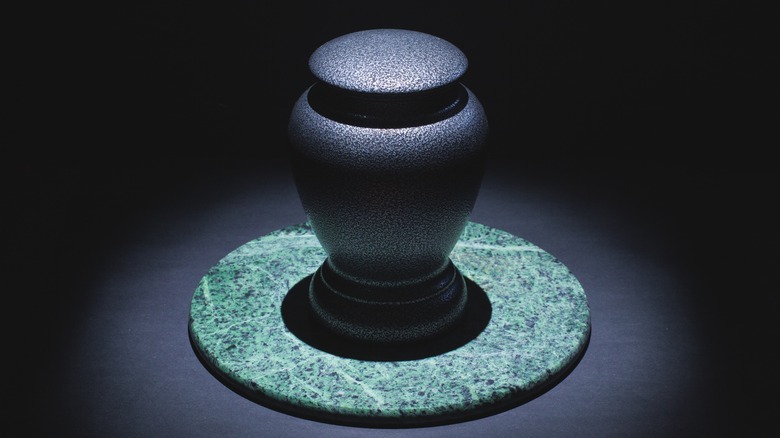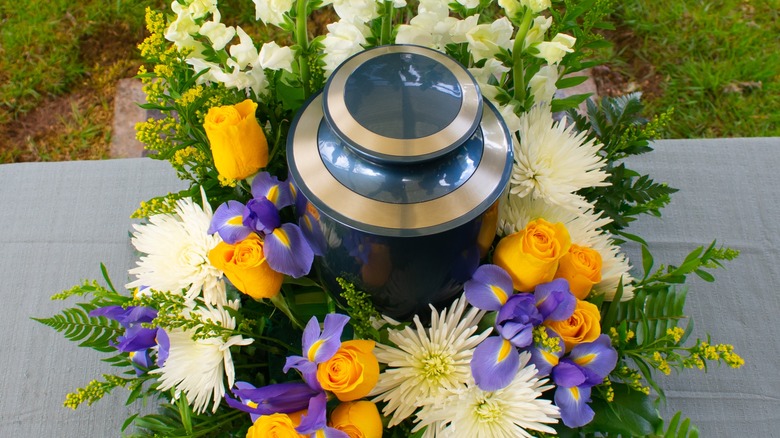Expert Reveals What's Really Left Of A Body After Cremation - Exclusive
Losing a loved one is never easy, and often leaves families in a state of shock and profound grief. In many cases, the planning and costs associated with the funeral and burial only compound an already difficult situation. The average cost of a funeral, in fact, is nearly $8,000 while services including cremation average a bit less than $7,000, based on 2022 reporting from Forbes. For these reasons and more, and as grieving families seek more cost-effective and efficient solutions, cremation has now replaced traditional burial as the most popular choice for dealing with a loved one's remains, according to CNN.
Although cremation has become increasingly popular in the last decade, many people are unaware of the specific details of the process, such as how will the body be prepared, and what if the loved one in question has non-biological objects surgically placed inside their body? As far as metal plates, rods, and staples, they are typically left in place because the cremation process will not completely dissolve the metal, as Green Cremation reports. Those objects, however, are then separated from the cremated remains prior to further processing.
The cremation process usually takes 2 ½ hours
During cremation, gold and silver fillings will also likely melt during the process as they generally contain alloys. For this reason, fillings such as those are usually also left intact before the cremation process begins, unless specifically requested by family members. Pacemakers, though, are one thing that absolutely needs to be removed prior to cremation. Pacemakers can explode during the cremation process and cause extensive damage to the furnace, as reported by leading cremation service provider Neptune Society.
As Cleveland Cremation also reports, silicone breast implants are also generally removed before cremation, as they can adhere to the other remains during the process. Crematoriums are also required by law to place the remains in a container, which is usually a cardboard box or special casket, before the body is placed inside the cremator — a high-powered furnace lined with heat-resistant refractory bricks or similar material (via Cremation Solutions).
Cremator furnaces are often fueled by natural gas or propane
The furnace in the cremator, fueled by natural gas or propane, is then lit until the temperature reaches 1500 to 1900°F. According to Cremation Solutions, the entire cremation process is generally complete within 2 1/2 hours. Speaking exclusively with Grunge, Sarah Chavez, Executive Director of the Order of the Good Death, a leading death acceptance organization said, "What is left after cremation is usually some brittle bone fragments and ash." And it typically takes approximately 30 minutes for the remains to cool before they can be further processed, as Cremation Solutions goes on to report.
Once cool, those remains, "are then carefully swept out by a crematory operator," Chavez continues. Those remains are then run through a magnetic field to remove any metal fragments, including surgical implants or parts of the casket, as Cremation Solutions also explains. The remaining bone fragments and ashes are then placed into a so-called cremulator, "which further breaks down the remaining bone fragments into what we commonly call 'ashes,'" Chavez says. Also according to Cremation Solutions, the processed ashes tend to resemble sand in texture and are generally a shade of gray.
Crematoriums have safeguards to make sure you get the right ashes
Once complete, the ashes of an average adult male weigh around 6 pounds, while the ashes of an adult female weigh around 4 pounds. The final weight of the ashes, however, depends more on a person's height at the time of death as opposed to their weight. One of the more common questions about cremation is how family members can be certain they are receiving the remains of their loved ones. To safeguard the process, crematoriums are regulated by law and are required to maintain valid licenses, as reported by National Cremation.
A vast majority of crematoriums also use metal identification tags, which are placed on the body prior to cremation and remain with the body throughout the entire process. That identification tag is removed from the bone fragments and attached to the container that is returned to the family or placed inside. Also according to the Order of the Good Death, some crematories will allow families to witness a cremation if they are more comfortable being present during the process. After the cremated remains are returned to the family, there are several options for what to do next: burying them, scattering the ashes in a special place, or keep them in an urn. Some people may also have them made into keepsake jewelry.



